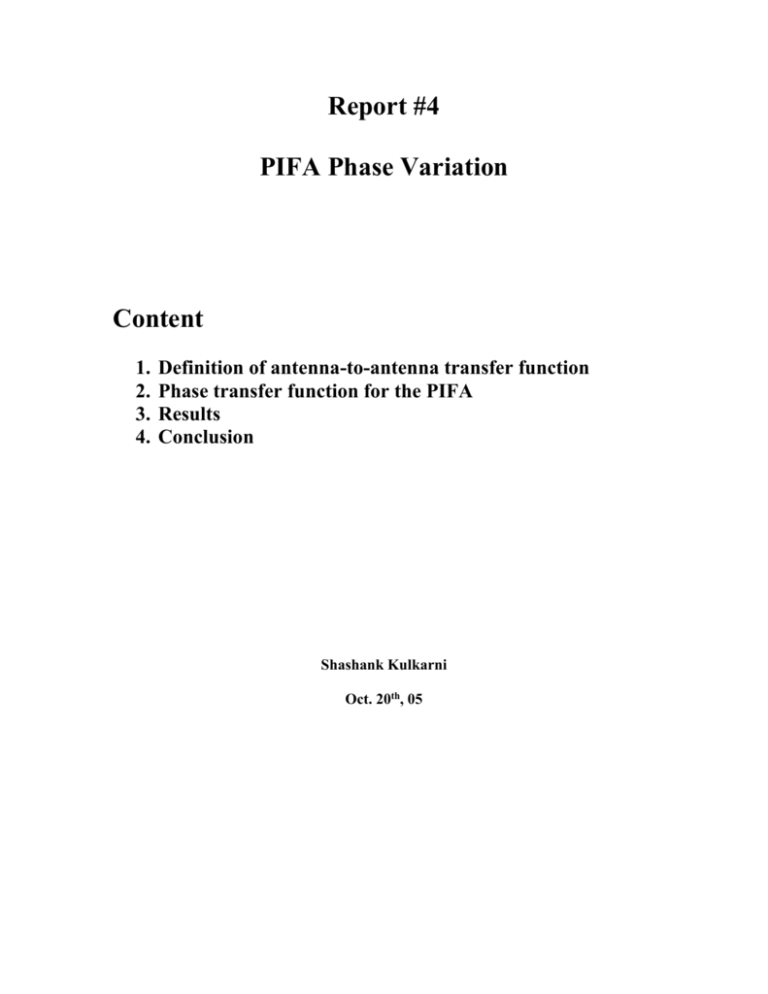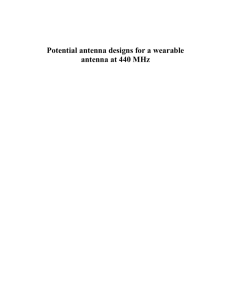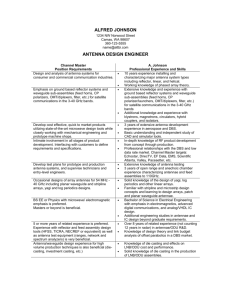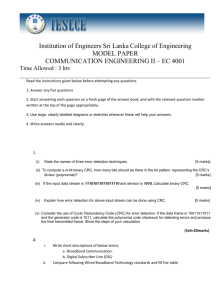Phase transfer function for a PIFA - Electrical & Computer Engineering
advertisement

Report #4 PIFA Phase Variation Content 1. 2. 3. 4. Definition of antenna-to-antenna transfer function Phase transfer function for the PIFA Results Conclusion Shashank Kulkarni Oct. 20th, 05 Definition of the antenna-to-antenna transfer function 1. 1.1. Literature review We first note that in the literature it is more common to consider a transfer function for a single antenna [1-4] rather than for a complete two-antenna system. In the present case, however, we are primarily interested in the antenna-to-antenna transfer function. For a two-antenna system, this transfer function is essentially a tool to estimate to what extend the spectrum of the transmitted signal is modified or distorted by both the transmitting and receiving antenna, and by their relative orientation. Te antenna-to-antenna transfer function can be obtained as a product of two individual antenna transfer functions in frequency domain [2, 3], with taking into account their relative orientation and the corresponding directivity factor. At the same time, the direct derivation can be given that is even simpler than the analysis for a single antenna. 1.2. Antenna-to-antenna transfer function Consider a link shown in Fig. 1a. The transmitting antenna is connected to an ideal voltage source Vin 1V . The receiving antenna is terminated in a matched load (50 Ω). The antenna-to antenna transfer function is then given by the ratio of two voltages, i.e. T ( ) V2 Vg (1) The transfer function can be expressed in terms of the S-parameters of the equivalent two-port network [5]. This network is shown in Fig. 1b. S11 is the reflection coefficient seen at port 1 (transmitting antenna) when port 2 (receiving antenna) is terminated in a matched load, i.e. S11 V1 V1 (2) Similarly, S 21 V2 V1 (3) so that V2 S21V1 (4) Now, we need to find V1 . For the transmitting antenna, one has V1 V1 1 Vg (5) Using Eqs. (2) and (5) gives V1 Vg (6) 1 S11 Therefore, Eq. (1) leads to T ( ) V2 S 21 V g 1 S11 (7) Eq. (7) is the main result of this section. It is used to numerically evaluate the transfer function for two antennas, using Ansoft HFSS simulator v.10.0 and the two-port antenna model. Alternatively, it can be used to measure the transfer function experimentally, using the Agilent 8722ET network analyzer. Note that Eq. (7) includes all possible decay/dispersion mechanisms between two antennas, including geometrical divergence. In order to eliminate the isotropic divergence (dependence on the distance between two antenna centers R), one may normalize Eq. (7) to 2R [3], i.e. T ( ) 2R S 21 1 S11 (8) Similarly, the linear phase drift with frequency is eliminated by multiplying Eq. (8) by [3] exp( jR / c) (9) etc. We will, however, use Eq. (7) directly as the absolute estimates may be of interest to us. 1.3. More realistic generator model If a practical voltage source is considered then a 50 Ω resistance is added in series with the ideal voltage source as shown in Fig. 1c. In this case, the resultant voltage applied to the transmitting antenna is obtained by using the voltage divider rule. If the antenna input impedance is complex, it would introduce a phase shift to the transfer function. However this phase shift would be independent of the relative antenna position. Therefore, we will not consider this modification of the transfer function either. Fig. 1. a) – Circuit schematic, b) – an equivalent two-port network representation, c) – the ideal voltage source replaced by a more realistic generator model. 2. Phase transfer function for the PIFA The transfer function simulations are carried out using Ansoft HFSS v10. The transmitting and receiving PIFA elements are separated by a distance of 5 m along the zaxis. The position of the transmitting antenna is fixed while the receiving antenna is rotated about the y- and z-axes keeping the distance between the antenna centers the same. The receiving PIFA element is rotated from the collinear position about the y and z axes, respectively. Fig. 2 shows the direction of rotation of the receiving antenna used to compute the antenna-to-antenna transfer function. The first (reference) case is when the two antennas are collinear. Fig.2. Rotations of the receiving PIFA element used for the computation of the antennato-antenna transfer function. The transmitting antenna is on the right. 3. Results The transfer function is calculated at 36 positions by rotating the receiving PIFA from 5 to 355 in steps of 10 about the y- axis – see Fig. 2 above. This is because the receiving PIFA is rotated towards and then away from the transmitting antenna and the image is not symmetric when observed from the transmitting antenna. The transfer function is also calculated at 18 positions by rotating the receiving PIFA from 5 to 175 in steps of 10 about the z- axis. In each of these cases, the Ansoft HFSS simulation has about 70,000 tetrahedra, which guarantees about 50 metal patches per wavelength. Fig 3 shows the plot of the phase variation as well as the magnitude variation over the operating bandwidth, both as functions of the antenna orientation. The phase variation is plotted on the logarithmic scale. Phase difference normalized by the center band phase difference is calculated in equation (1). (1) norm , ,0 0 , 0 ,0 where , is the phase response for any given orientation of the receiving antenna at any frequency over the antenna bandwidth, ,0 is the phase response when the receiving antenna is collinear to the transmitting antenna at any frequency over the antenna bandwidth, 0 , is the phase response for any given orientation of the receiving antenna, at the center frequency, and 0 ,0 is the phase response when the receiving antenna is collinear to the transmitting antenna, at the center frequency. The center frequency is chosen as 440 MHz. The parameter calculated in equation (1) is plotted over the antenna bandwidth for the PIFA elements in Figs. 4, 5 and 6. The scale on these figures follows Prof. Cyganski’s suggestion. Fig. 3 is only given to support our preliminary conclusion done in report #2 – the higher phase variation is observed only for the degenerate cases of the strong polarization mismatch. Fig 3. Phase and magnitude variation over the operating bandwidth as a function of the antenna orientation. The phase variation vs. the collinear case is plotted on a logarithmic scale.–a) Rotation of the PIFA about z-axis. The red line indicates a phase variation of 2; –b) rotation of the PIFA about the y-axis. The red line indicates a phase variation of 6. Fig 4. Phase difference normalized by the center band phase difference for a PIFA rotated about the z-axis –a) full scale variation; –b) magnified version of the first plot showing a phase variation over 10. Fig 5. Phase difference normalized by the center band phase difference for a PIFA rotated about the y-axis –a) full scale variation; –b) magnified version of the first plot showing a phase variation over 10. Fig 6. Phase difference normalized by the center band phase difference for a PIFA rotated about the y-axis –a) full scale variation; –b) magnified version of the first plot showing a phase variation over 10. 4. Conclusion If we neglect the degenerate cases for the PIFA, the average phase variation vs. the collinear case is obtained as 6 per 14.55% bandwidth. This is BETTER than for the metal monopole (Report #2) but slightly worse than for the dipole (Report #2). References 1. D. Lamensdorf and L. Susman,” Baseband-pulse-antenna technique”, Antennas and Propagation Magazine, vol. 36, no. 1, Feb. 1994, pp. 20 – 30. 2. Ma Tzyh-Ghuang and Jeng Shyh-Kang, "Planar miniature tapered-slot-fed annular slot antenna for ultrawide-band radios," IEEE Trans. Antennas and Propagation, vol.-53, no. 3, March 2005, pp. 1194-1202. 3. B. Scheers, M. Acheroy, and A. Vander Vorst, "Time-domain simulation and characterization of TEM horns using a normalized impulse response," IEE Proc.Microw. Antennas Propagation, vol.-147, no. 6, December 2000, pp. 463-468. 4. S. Zwierzchowski and P. Jazayeri, "A system and network analysis approach to antenna design for UWB communications," Antennas and Propagation Society International Symposium, vol. -1, June 2003, pp. 826-829. 5. D. M. Pozar, Microwave Engineering, Wiley, 2005, 3rd ed.




